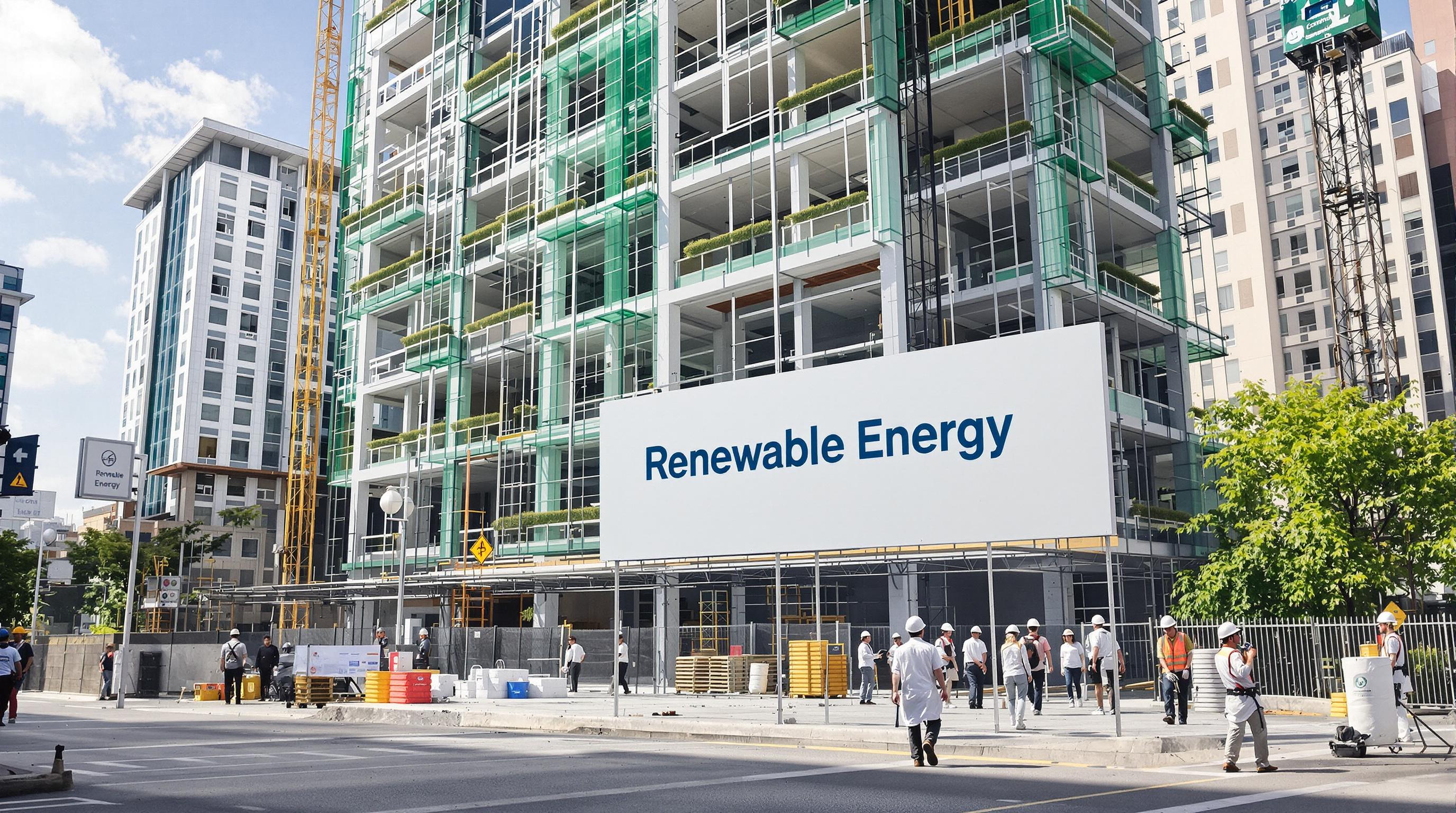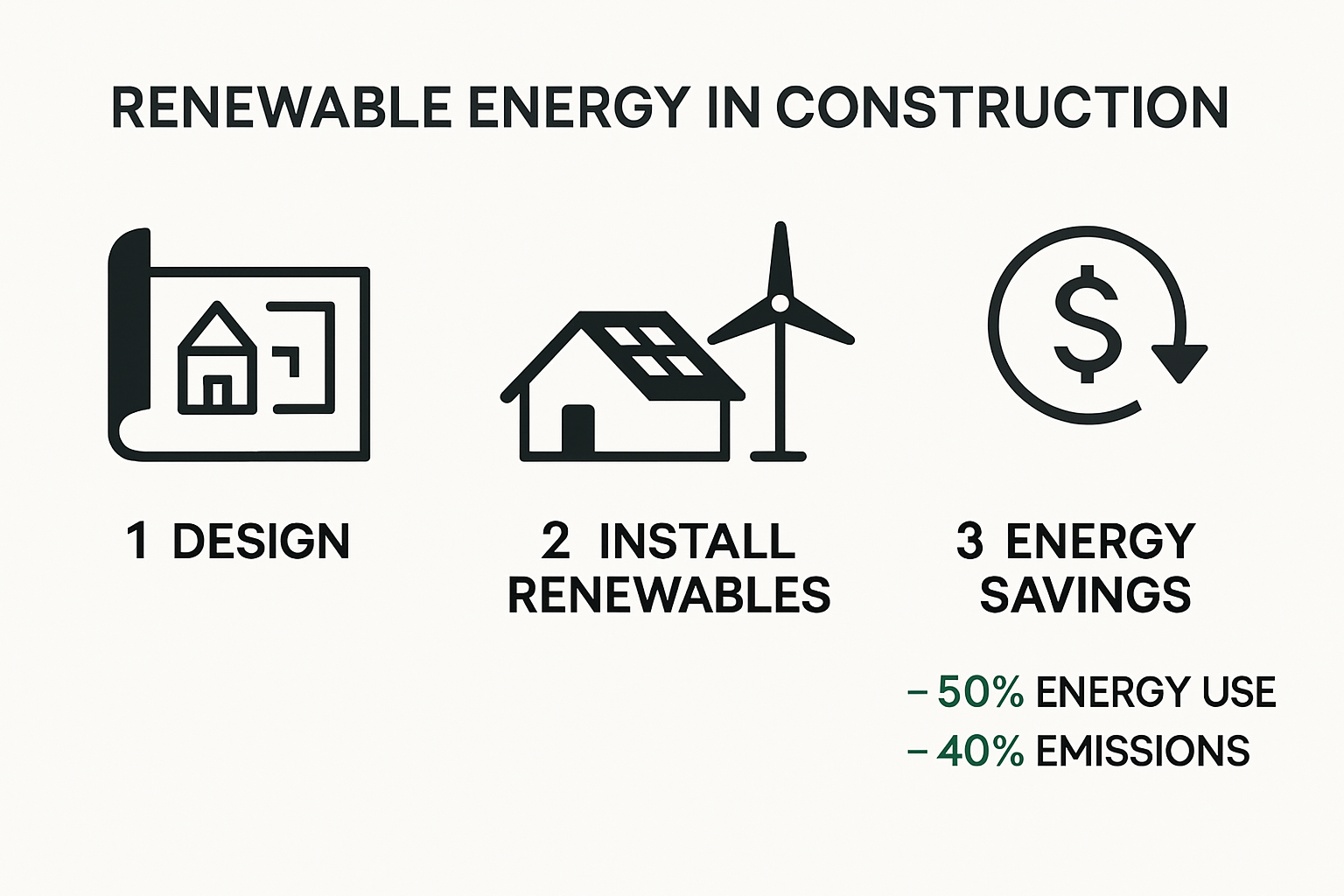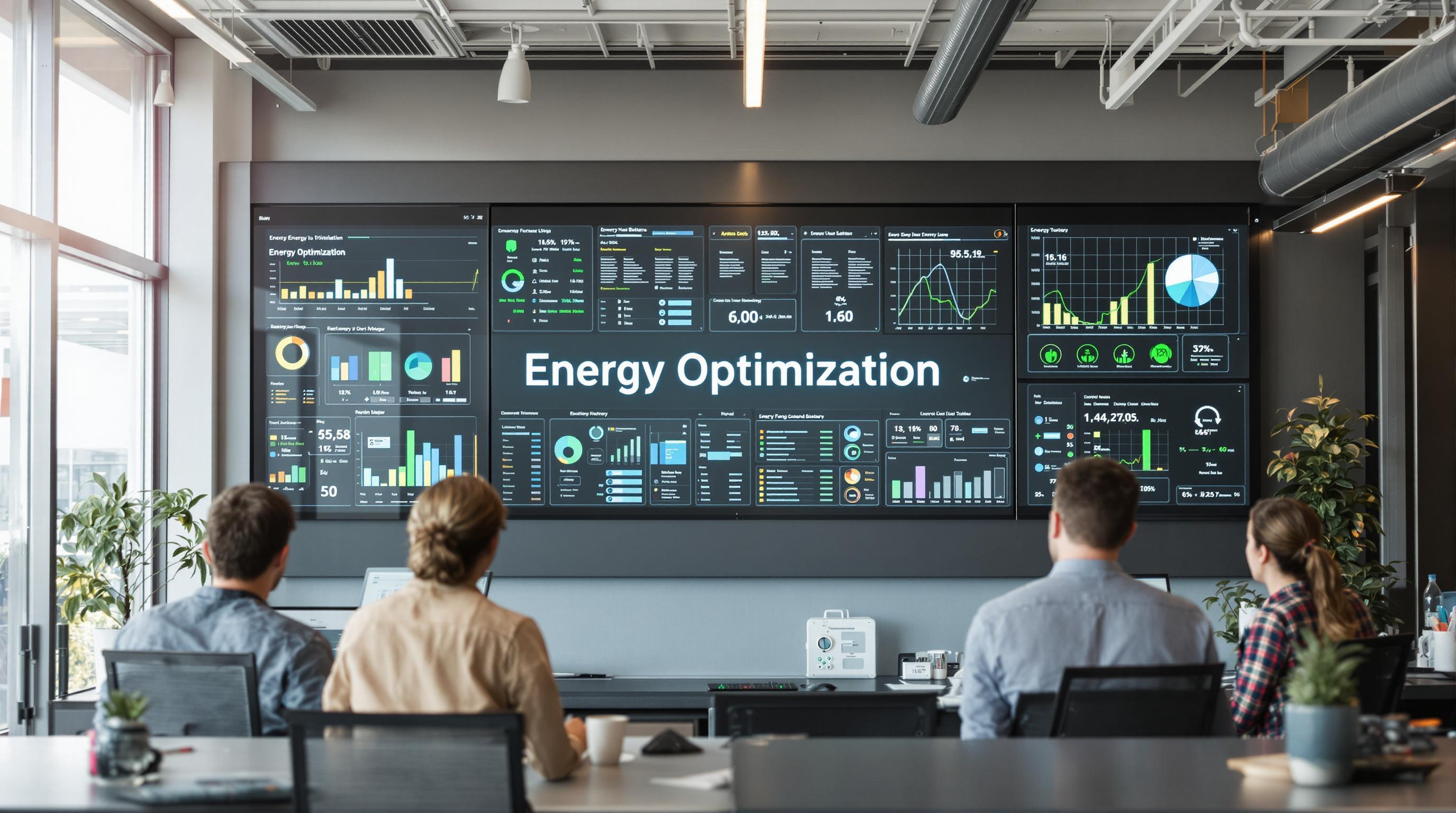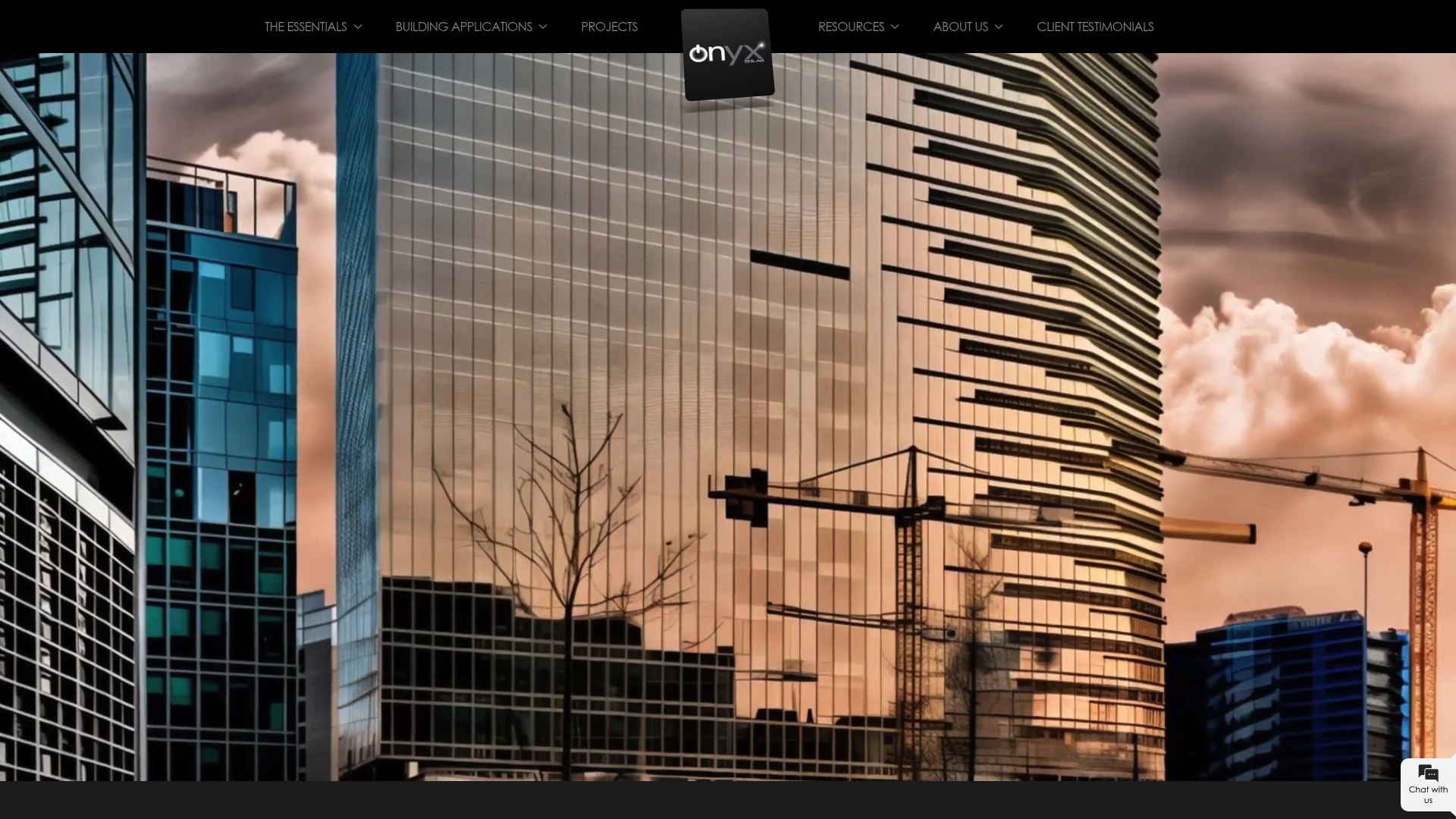
July 16, 2025
Onyx Solar USA
79 Madison Avenue, Ste. #231
New York, NY 10016
usa@onyxsolar.com
+1 917 261 4783
Onyx Solar Spain
Calle Río Cea 1, 46,
05004 Ávila. Spain.
info@onyxsolar.com
+34 920 21 00 50

Renewable energy is changing how buildings are designed and built. Buildings now account for about 40 percent of global energy use and 30 percent of worldwide CO₂ emissions. Surprised? Those concrete giants are doing more harm than most factories. Here is the twist. By 2025, the construction industry is not just facing new rules, it is jumping ahead with smarter tech and fresh incentives that turn every project into an opportunity to reshape the future.
| Takeaway | Explanation |
|---|---|
| Integrate Renewable Energy from the Start | Architects and developers should adopt holistic design practices that view buildings as energy generators to significantly reduce carbon emissions and enhance sustainability. |
| Leverage Advanced Technologies | Utilizing AI, building-integrated photovoltaics, and smart materials can optimize energy generation and management, leading to improved efficiency and sustainability in construction. |
| Stay Ahead with Regulatory Compliance | Understanding and adhering to evolving regulations and incentives for renewable energy integration is crucial for competitive advantage and market leadership in the construction industry. |
| Harness Economic and Operational Benefits | Engaging in renewable energy projects can lower operating costs, enhance building valuation, and improve resilience, which are critical for attracting clients and achieving long-term success. |
| Differentiate Professionally | Professionals with expertise in renewable energy and sustainable design will stand out in the marketplace, positioning themselves as leaders in a rapidly changing industry. |
Renewable energy integration in construction represents a critical strategy for transforming the built environment into an active contributor to sustainable infrastructure. Architects and developers now recognize that buildings are not just passive structures but potential energy generators capable of significantly reducing carbon emissions and supporting a decarbonized economy.

The foundation of successful renewable energy integration lies in holistic design thinking that considers energy performance from the initial conceptual stages. Explore our comprehensive solar design strategies for understanding how architectural elements can simultaneously serve aesthetic and energy production purposes.
According to research in Sustainability, buildings currently account for approximately 40% of global energy use and 30% of worldwide CO₂ emissions. This stark statistic underscores the urgent need for transformative design strategies that prioritize renewable energy incorporation. Architects must now view building envelopes not as static barriers but as dynamic interfaces capable of energy generation and conservation.
Effective renewable energy integration demands a multifaceted approach. The Whole Building Design Guide recommends implementing climate-responsive design practices that include:
A groundbreaking study published in the Science and Technology for Energy Transition demonstrated remarkable potential for green building designs. By integrating renewable energy sources comprehensively, projects can potentially:
These metrics represent more than theoretical potential they signify a tangible pathway toward sustainable architectural practice. Modern building design must transcend traditional boundaries, viewing renewable energy not as an add-on but as a fundamental design principle.
Successful integration requires collaboration among architects, engineers, energy specialists, and materials scientists. Each building becomes a unique ecosystem where technological innovation meets environmental responsibility. The goal is no longer just constructing shelter but creating intelligent, responsive structures that actively contribute to global sustainability efforts.
As we progress into 2025 and beyond, renewable energy in construction will not be optional but essential. Architects and developers who embrace this paradigm will lead the transformation toward a more sustainable, energy-efficient built environment.
The construction industry stands at the forefront of technological innovation, with renewable energy technologies rapidly transforming traditional building practices. Modern architects and developers are leveraging cutting-edge solutions that not only generate clean energy but also integrate seamlessly with architectural design.
Artificial Intelligence (AI) is revolutionizing renewable energy systems in construction. Learn about advanced photovoltaic technologies that are reshaping how buildings interact with energy networks. According to research from Time Magazine, AI implementation in building systems has demonstrated remarkable efficiency gains. In one Manhattan building, AI-driven optimization of HVAC systems reduced energy consumption by 15.8%, translating to annual savings of $42,000 and eliminating 37 metric tons of carbon dioxide emissions.
Building-Integrated Photovoltaics (BIPV) represent another breakthrough technology. Research from Wikipedia highlights how these systems integrate photovoltaic materials directly into building components like roofs, facades, and windows. This approach eliminates the need for separate solar installations while simultaneously enhancing structural functionality and aesthetic appeal.
Offshore wind technology is experiencing significant technological advancements. Artificial Intelligence research is enabling more sophisticated design and optimization of wind turbine towers, addressing critical challenges in scaling up renewable energy infrastructure. These AI-driven approaches facilitate the development of more efficient and sustainable structures, particularly in challenging offshore environments.
Key technological innovations in renewable energy construction include:

Energy storage technologies are critical to the successful implementation of renewable energy in construction. Explore our comprehensive storage solutions guide to understand the latest advancements in energy retention and management. Modern storage systems now utilize advanced battery technologies, machine learning algorithms, and predictive maintenance techniques to maximize energy efficiency.
The convergence of renewable energy technologies demonstrates that construction is no longer just about creating physical structures. Today’s buildings are intelligent ecosystems that actively generate, manage, and optimize energy consumption. Architects and developers who embrace these technologies are not just designing buildings they are creating sustainable, responsive environments that contribute meaningfully to global decarbonization efforts.
As we move further into 2025, the integration of AI, advanced materials, and sophisticated energy management systems will continue to push the boundaries of what’s possible in renewable energy construction. The future of building design is not just green it is smart, adaptive, and fundamentally transformative.
Regulatory frameworks and economic incentives are rapidly becoming the primary drivers of renewable energy adoption in construction. Governments worldwide are implementing sophisticated policy mechanisms that transform sustainable building from an optional strategy to a mandatory requirement.
The international regulatory environment is experiencing a significant transformation. Understand the evolving policy frameworks that are reshaping renewable energy deployment. According to the European Union’s Renewable Energy Directive, member states must ensure that by 2030, at least 42.5% of their total energy consumption comes from renewable sources. This ambitious target represents a substantial shift in national energy policies.
In Asia, countries are implementing increasingly stringent regulations. Research from Reuters highlights China’s groundbreaking Renewable Portfolio Standards (RPS) for critical industries like steel, cement, and polysilicon. These standards mandate specific renewable energy consumption percentages, with particular emphasis on emerging sectors such as data centers.
Zero-Energy Building (ZEB) requirements are becoming a pivotal regulatory mechanism. According to Wikipedia, South Korea has implemented comprehensive ZEB policies that progressively mandate energy-neutral construction. By 2024, all public buildings must comply with ZEB standards, with private sector regulations expanding to cover buildings over 1,000 m² by 2025.
Key regulatory strategies emerging globally include:
Beyond regulatory mandates, governments are developing sophisticated economic incentives to accelerate renewable energy adoption. These include:
The convergence of regulatory pressure and economic incentives is creating a powerful ecosystem that makes sustainable construction not just environmentally responsible but economically attractive. Architects, developers, and construction professionals are now operating in a landscape where renewable energy integration is both a compliance requirement and a strategic business opportunity.
As we progress through 2025, these regulatory frameworks will continue to evolve, becoming increasingly sophisticated and interconnected. The future of construction is being written by policy makers, technologists, and sustainability experts who recognize that the built environment plays a critical role in global decarbonization efforts.
The message is clear: sustainable construction is no longer an option but a fundamental requirement for building in the 21st century. Professionals who understand and proactively adapt to these emerging regulatory landscapes will lead the next generation of architectural innovation.
Professionals in architecture, construction, and development are experiencing a transformative era where renewable energy integration is no longer just an environmental imperative but a strategic business advantage. The landscape of sustainable design is rapidly evolving, offering unprecedented opportunities for innovation, cost optimization, and professional differentiation.
Explore comprehensive solar energy storage strategies that can revolutionize project economics. According to research from the Government Accountability Office, integrating renewable energy technologies can significantly reduce operational costs by lowering energy bills and enhancing overall energy efficiency.
Key economic benefits for professionals include:
Research from Government Accountability Office studies demonstrates that renewable energy sources significantly improve building resilience. These systems provide reliable energy supply during grid outages, ensuring continuous operation and minimizing potential downtime for critical infrastructure.
Additionally, environmental health research reveals substantial improvements in indoor environmental quality when renewable energy systems are integrated. Professionals can expect:
In 2025, renewable energy expertise is becoming a critical competitive advantage. Professionals who demonstrate advanced capabilities in sustainable design and renewable energy integration position themselves as industry leaders. Community solar project insights highlight the growing demand for professionals who can navigate complex renewable energy landscapes.
Strategic benefits include:
The renewable energy transition represents more than a technological shift it is a comprehensive reimagining of professional practice. Architects, engineers, and developers who embrace these technologies are not just adapting to change they are actively shaping the future of sustainable infrastructure.
As regulatory frameworks continue to evolve and economic incentives grow, the professionals who invest in renewable energy expertise will find themselves uniquely positioned to lead in an increasingly complex and sustainability-driven market. The message is clear: renewable energy is no longer an optional strategy but a fundamental component of professional excellence in 2025 and beyond.
To clarify the statistical impact and methodologies mentioned, the following table summarizes the key results from green building design integration based on the cited study:
| Metric | Improvement/Rates |
|---|---|
| Energy Consumption Reduction | Up to 50.54% |
| Total Energy Cost Reduction | Up to 57.41% |
| Monthly CO₂ Emissions Reduction | Up to 50.54% |
Below is a table summarizing the regulatory and incentive mechanisms shaping sustainable projects globally, as discussed in the relevant section:
| Region/Policy | Key Requirement/Strategy | Timeline/Target |
|---|---|---|
| EU Renewable Energy Directive | 42.5% of total energy from renewables | By 2030 |
| China Renewable Portfolio | Mandatory renewable mix for steel, cement, polysilicon, and data centers | 2025 onward |
| South Korea ZEB Mandate | ZEB for all public buildings, private sector buildings >1,000 m² | Public: by 2024, Private: 2025 |
| Tax Incentives & Rebates | Financial incentives for sustainable construction | Ongoing, varies by country |
| Performance-Based Codes | Strict energy efficiency for all new developments | Ongoing, rolling adoption |
Renewable energy strategies for 2025 projects include integrating energy-generating technologies into building designs, utilizing advanced materials like building-integrated photovoltaics (BIPV), and implementing performance-driven methodologies for energy efficiency.
Architects and developers can integrate renewable energy by adopting holistic design practices that view buildings as energy generators, utilizing passive solar design, and incorporating high-performance building envelopes and renewable energy systems into their initial designs.
Renewable energy technologies can significantly reduce operational costs, enhance building valuation, improve resilience during outages, and contribute to lowering carbon emissions, providing both economic and environmental advantages for construction projects.
Construction professionals should be aware of regulations such as the European Union’s Renewable Energy Directive, Zero-Energy Building mandates in countries like South Korea, and various national tax incentives geared toward promoting sustainable construction practices.
Are you struggling to meet strict 2025 renewable energy goals without sacrificing design or function? This article points out your unique challenge: finding building solutions that generate clean energy, slash carbon emissions, and stay visually impressive. If you want to cut energy costs, deliver zero-energy buildings, and set your project apart, you need reliable solutions that go beyond traditional architecture. Onyx Solar’s advanced photovoltaic glass is designed for exactly this purpose. Fully integrate innovative BIPV technologies into facades, skylights, and more for real performance, proven by over 500 global projects. Check our case studies and consulting resources to see this technology in action.

Stay ahead of evolving regulations and rising client demands. Visit Onyx Solar now for expert support and real project inspiration. Take the next step toward smarter, energy-generating buildings that put you in the lead for 2025 and beyond.
Over 500 projects completed across 60 countries on all five continents.
Learn how our photovoltaic solutions are shaping the future of architecture.
Explore our full catalogue available in PDF or as an AUDIOBOOK.